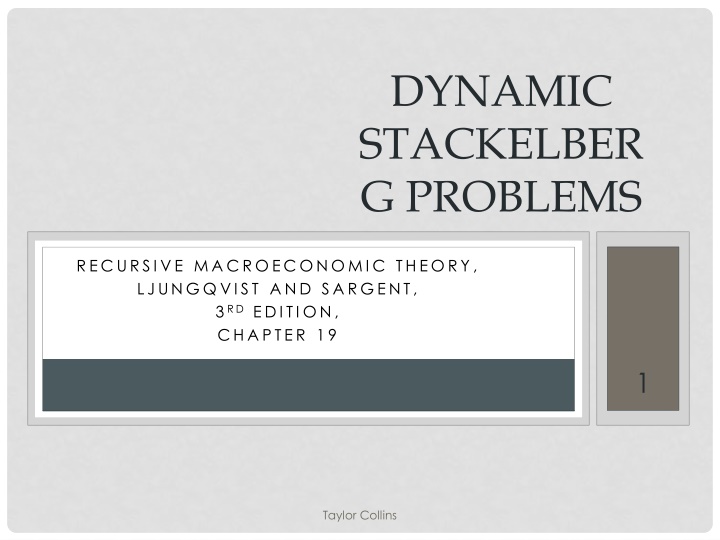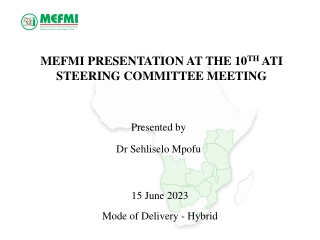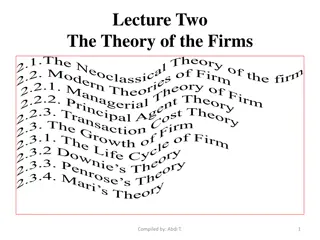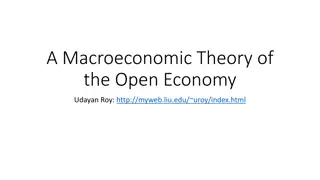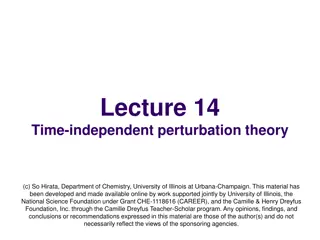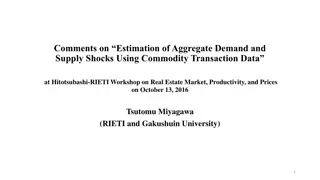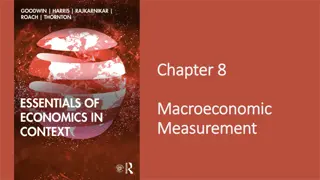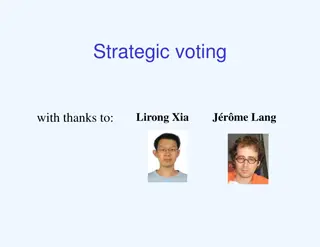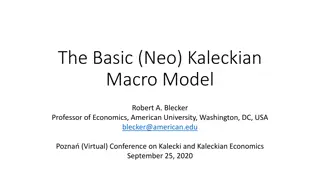Dynamic Stackelberg Problems in Macroeconomic Theory
A new type of problem in economic theory known as Dynamic Stackelberg Problems is discussed, focusing on optimal decision rules, rational expectations equilibrium, and the Stackelberg leader and follower concept. The government's one-period loss function, solving methods, and dynamics of Lagrange multipliers are explored to maximize decision-making efficiency. Step-by-step algorithms are provided to solve the Stackelberg Problem effectively in a competitive market setting with forward-looking abilities.
Download Presentation

Please find below an Image/Link to download the presentation.
The content on the website is provided AS IS for your information and personal use only. It may not be sold, licensed, or shared on other websites without obtaining consent from the author.If you encounter any issues during the download, it is possible that the publisher has removed the file from their server.
You are allowed to download the files provided on this website for personal or commercial use, subject to the condition that they are used lawfully. All files are the property of their respective owners.
The content on the website is provided AS IS for your information and personal use only. It may not be sold, licensed, or shared on other websites without obtaining consent from the author.
E N D
Presentation Transcript
DYNAMIC STACKELBER G PROBLEMS RECURSI VE MACROECONOMI C THEORY, LJUNGQVI ST A ND SA RGENT, 3RD EDI TI ON, CHAPTER 19 1 Taylor Collins
BACKGROUND INFORMATION A new type of problem Optimal decision rules are no longer functions of the natural state variables A large agent and a competitive market A rational expectations equilibrium Recall Stackelberg problem from Game Theory The cost of confirming past expectations Taylor Collins 2
THE STACKELBERG PROBLEM Solving the problem general idea Defining the Stackelberg leader and follower Defining the variables: Zt is a vector of natural state variables Xt is a vector of endogenous variables Ut is a vector of government instruments Yt is a stacked vector of Zt and Xt Taylor Collins 3
THE STACKELBERG PROBLEM The government s one period loss function is r(y,u)= y'Ry+u'Qu Government wants to maximize - btr(yt,ut) (1) t=0 subject to an initial condition for Z0, but not X0 Government makes policy in light of the model = +But zt+1 xt+1 A11A12 A21A22 zt xt yt+1= Ayt+But (2) The government maximizes (1) by choosing {ut,xt,zt+1}t=0 subject to (2) Taylor Collins 4
PROBLEM S The Stackelberg Problem is to maximize (2) by choosing an X0 and a sequence of decision rules, the time t component of which maps the time t history of the state Zt into the time t decision of the Stackelberg leader. The Stackelberg leader commits to a sequence of decisions The optimal decision rule is history dependent Two sources of history dependence Government s ability to commit at time 0 Forward looking ability of the private sector Dynamics of Lagrange Multipliers The multipliers measure the cost today of honoring past government promises Set multipliers equal to zero at time zero Multipliers take nonzero values thereafter Taylor Collins 5
SOLVING THE STACKELBERG PROBLEM 4 Step Algorithm Solve an optimal linear regulator Use stabilizing properties of shadow prices Convert Implementation multipliers into state variables Solve for X0 and x0 Taylor Collins 6
STEP 1: SOLVE AN O.L.R. Assume X0 is given This will be corrected for in step 3 With this assumption, the problem has the form of an optimal linear regulator The optimal value function has the form v(y) = -y'Py where P solves the Riccati Equation The linear regulator is subject to an initial Y0 and the law of motion from (2) Then, the Bellman Equation is -y'Py = max bt(yt'Ryt+ut'Qut) v(y0) = -y0Py0 = - max {ut,yt+1}t=0 t=0 u,y*{-y'Ry-u'Qu-by*'Py*} s.t. y*= Ay+Bu (3) Taylor Collins 7
STEP 1: SOLVE AN O.L.R. Taking the first order condition of the Bellman equation and solving gives us u = -Fy s.t. F =b[Q+bB'PB]-1B'PA (4) Plugging this back into the Bellman equation gives us -y'Py = -y'Ry-u -b(Ay+Bu _'Qu _ _ _ )'P(Ay+Bu ) such that is optimal, as described by (4) Rearranging gives us the matrix Riccati Equation P=R+bA'PA-b2A'PB(Q+bB'PB)-1B'PA Denote the solution to this equation as P* Taylor Collins 8
STEP 2: USE THE SHADOW PRICE Decode the information in P* Adapt a method from 5.5 that solves a problem of the form (1),(2) Attach a sequence of Lagrange multipliersto the sequence of constraints (2) and form the following Lagrangian L = - bt[y'tRyt+u'tQ ut+2bm't+1(Ayt+But-yt+1)] t=0 Partition t conformably with our partition of Y Taylor Collins 9
STEP 2: USE THE SHADOW PRICE Want to maximize L w.r.t. Ut and Yt+1 L ut=0 L yt=0 0=Qut+bB'mt+1 mt= Ryt+BA'mt+1 (5 ) Solving for Ut and plugging into (2) gives us yt+1= Ayt-bBQ-1B'mt+1 Combining this with (5), we can write the system as I bBQ-1B' 0 bA' mt+1 -R = = N 0 I yt+1 A yt mt L*yt+1 mt+1 yt mt (6 ) Taylor Collins 10
STEP 2: USE THE SHADOW PRICE We now want to find a stabilizing solution to (6) ie, a solution that satisfies bty'tyt < t=0 In section 5.5, it is shown that a stabilizing solution satisfies m0=P*y'0 Then, the solution replicates itself over time in the sense that mt= P*y't (7) Taylor Collins 11
STEP 3: CONVERT IMPLEMENTATION MULTIPLIERS We now confront the inconsistency of our assumption on Y0 Forces multiplier to be a jump variable Focus on partitions of Y and Convert multipliers into state variables Write the last nx equations of (7) as mxt=P21zt+P22xt (8) Pay attention to partition of P Solving this for Xt gives us xt=P22 -1mxt-P22 -1P21zt Taylor Collins 12
STEP 3: CONVERT IMPLEMENTATION MULTIPLIERS Using these modifications and (4) gives us I 0 -P22 P22 zt mxt ut=-F (9) -1P21 -1 We now have a complete description of the Stackelberg problem yt+1= Ayt+But zt+1 mt+1 P21 P22 zt mxt = (A-BF) 0 zt mxt I 0 I (9 ) -1P21 -1 -P22 P22 -1P21 -1 xt= -P22 P22 (9 ) Taylor Collins 13
x0 STEP 4: SOLVE FOR X0 AND The value function satisfies v(y0)=-y'0P*y0=-z'0P11 *z0-2x'0P21 *z0-x'0P22 *x0 Now, choose X0 by equating to zero the gradient of V(Y0), w.r.t. X0 -2P21 *-1P21 *z0-2P22 *x0=0 x0=-P22 *z0 Then, recall (8) (8) mx0=0 Finally, the Stackelberg problem is solved by plugging in these initial conditions to (9), (9 ), and (9 ) and iterating the process to get {ut,xt,zt+1}t=0 Taylor Collins 14
CONCLUSION Brief Review Setup and Goal of problem 4 step Algorithm Questions, Comments, or Feedback Taylor Collins 15
